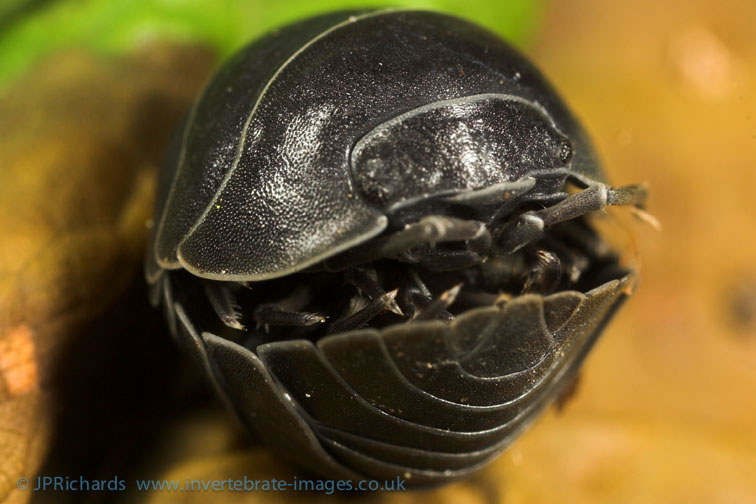Armadillidium depressum Brandt in Brandt & Ratzeburg, 1831
Common name
Status:
GB IUCN status: Least Concern
ID Difficulty
Identification
Our seven Armadillidium species and Eluma caelata (Family Armadillidiidae) are readily recognised in the field by their truncated 'square' uropods that end flush with the body and their ability to roll into a protective sphere (similar truncated uropods are also seen in the non-native Armadillidae species).
This large pill-woodlouse (to 20 mm body length) is typically slate grey, sometimes flecked with yellow, and thus reminiscent of the common A. vulgare. Armadillidium depressum differs in the pleon being more curved outwards, giving a 'splayed' or 'flattened' appearance and in the scutellum being raised as a broad plate visible between the antennae. The male 1st pleopods are diagnostic.
Small immatures look very different from the adults, typically being brownish grey and flecked with an ornate yellow pattern (see images).
Distribution
With a distinct south-western bias, this species remains locally frequent in parts of south west England, south Wales and along parts of the south coast. However, in the last few decades it has become apparent that the distribution of this species has expanded much further north and east with a wide scattering of records across much of England and Wales. In 2020 A. depressum was recorded from south-west Scotland for the first time (BMIG Newsletter 41, pg 5-6) and in 2024 it was recorded from a cemetery in Edinburgh, an additional 100km north! In Ireland there is a handful of records, mainly from the south east, with two new sites added in 2023 from Co. Laois (in a house) and Co. Carlow (on a wall) by Ciarán Byrne. An updated distribution map is given in Gregory (2024).
Habitat
Armadillidium depressum is heavily synanthropic and typically occurs on dry limestone walls or loosely mortared walls in towns, villages and farmyards, or on weathered rock faces in quarries and railway cuttings.
It can be found under loose stones, especially capping stones on walls. It may occur in large numbers inside old houses. It also occurs under rocks and stones in railway cuttings and disused quarries where limestone is exposed. It can be much easier to find at night (torch-light surveys) when it is active on the surface. It has also been recorded from the trunks of Beech trees (Alexander, 2011).
Typically, it is associated with A. vulgare, Porcellio scaber and more rarely P. spinicornis.
This summary is based on the detailed account in Gregory (2009), updated in Gregory (2024).
References
Gregory, S. (2009) Woodlice and Waterlice (Isopoda: Oniscidea & Asellota) in Britain and Ireland. Field Studies Council/Centre for Ecology & Hydrology.
Links
World List of Marine, Freshwater and Terrestrial Isopod Crustaceans: https://www.marinespecies.org/isopoda/aphia.php?p=taxdetails&id=148675












